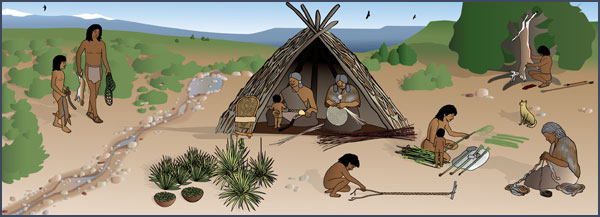Peoples of the Mesa Verde Region
Archaic: 6000 to 500 B.C.Overview
If you fell asleep during the Paleoindian period and woke up in the Archaic period, probably the first thing you would notice is that the climate had gotten a lot warmer and drier. And many of the large animals that you had counted on for your livelihood, including mammoths and mastodons, were no longer around. BIG environmental changes meant having to make some adjustments to your lifestyle. 
An Archaic camp. Of course, the change from the Paleoindian period to the Archaic period did not happen overnight. Over a period of many centuries, the environment gradually became more similar to what we are accustomed to today. The warmer and drier conditions contributed to the extinction of the megafauna that had roamed North America during the Paleoindian period. And some scientists believe that intensive hunting by humans may have further hastened the extinction of several species such as mammoths, mastodons, and an ancient form of bison. So how did Archaic peoples adjust to their changing world? Although they continued their nomadic, hunter-gatherer lifestyle, their prey consisted entirely of animals familiar to us today: deer, elk, bighorn sheep, rabbits, and rodents. In addition, Archaic peoples became increasingly dependent on wild plant foods to round out their diet. And, late in the Archaic period, corn and squash made their first appearance on the Colorado Plateau, although the introduction of these domesticated plants did not have a major impact on lifeways until the subsequent Basketmaker II period. As human populations increased throughout North America during the Archaic period, the territories of individual bands became smaller and more clearly defined than was the case during the Paleoindian period. And with groups ranging in smaller areas, distinct local traditions began to develop, as reflected in the different styles of artifacts and houses dating from this period. 
Archaic peoples from southern Arizona migrated to the Colorado Plateau, where they met other Archaic peoples who were already living there. Two such local traditions figure prominently in the history of the Mesa Verde region: one that developed on the Colorado Plateau (which includes the Mesa Verde region), and another that developed in southern Arizona, in the vicinity of present-day Tucson. Archaeologists think that Archaic peoples from southern Arizona migrated north to the Colorado Plateau, bringing not only their own distinctive language, artifacts, and house styles but also seeds of domesticated plants and knowledge of plant cultivation. This is probably how the Archaic peoples who were already living on the Colorado Plateau first learned about agriculture.
. . . about the beginnings of agriculture in North America and the Southwest. How do archaeologists know that Archaic peoples had smaller territories than Paleoindian peoples? How do archaeologists know that different local traditions developed during the Archaic period? |
|
Acknowledgments | Illustration credits | To borrow, cite, or request permission | Please take our survey! Title page for Peoples of the Mesa Verde Region |
|
 DONATE TODAY
DONATE TODAY
